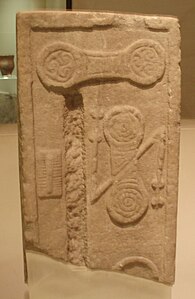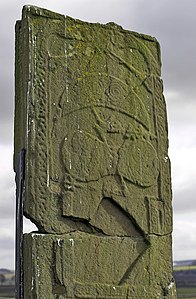Double disc (Pictish symbol)
Appearance
The double disc is a Pictish symbol of unknown meaning, that is frequently found on Class I and Class II Pictish stones,[1] as well as on Pictish metalwork.[2][3] The symbol can be found with and without an overlaid Z-rod (also of unknown meaning), and in combinations of both (as with the Monifieth 1 stone).
Gallery
-
Aberlemno 1; Class I stone with double disc and Z rod
-
Dunnichen Stone; Class I with double disc and Z rod
-
Aberlemno 3 rear face detail; Class II
-
Monifieth 1; Class II stone with double discs with and without Z-rod
-
Detail of penannular ring on Whitecleuch Chain showing double disc and Z-rod
-
Plaque from Norrie's Law hoard showing Double disc and Z-rod
-
Fordoun stone
-
Picardy stone
-
Woodwrae Stone rear face
References
- ^ Fraser, Iain (2008), The Pictish Symbol Stones of Scotland, Edinburgh: Royal Commission on the Ancienct and Historic Monuments of Scotland
- ^ Graham-Campbell, James (1991), "Nome's Law, Fife: on the nature and dating of the silver hoard" (PDF), Proceedings of the Society of Antiquaries of Scotland, 121: 241–259, archived from the original (PDF) on June 11, 2007, retrieved August 2, 2010
- ^ Clark, J Gilchrist (1880), "Notes on a Gold Lunette found at Auchentaggart, Dumfriesshire, and a Massive Silver Chain found at Whitecleugh, Lanarkshire, exhibited by His Grace The Duke of Buccleuch." (PDF), Proceedings of the Society of Antiquaries of Scotland, 14: 222–224, retrieved August 1, 2010











